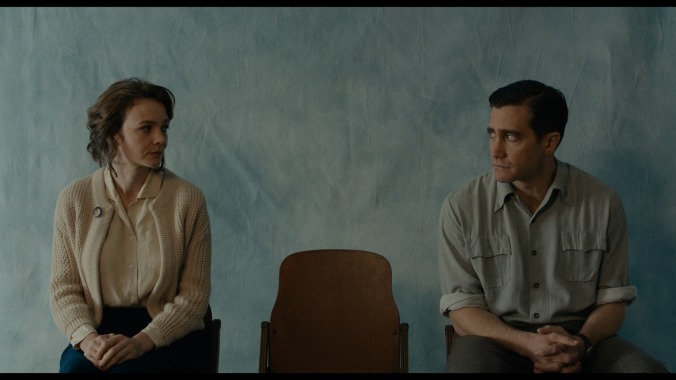Dano, though, has come prepared, and he’s chosen his collaborators well. As shot by cinematographer Diego García (Cemetery Of Splendor, Neon Bull), Wildlife distinguishes itself by relying less on showy movements than on mostly static framings and meticulous compositions—an approach that also gestures to Joe’s part-time job at a local portrait photography studio. A sequence that observes Joe and his mother driving to the wildfire his father left them for presents vistas of foreboding, pictorial beauty alongside frames that make canny use of offscreen space. At the same time, the film’s period detail, courtesy of production designer Akin McKenzie and costume designer Amanda Ford, is immaculately rendered, with textured pastel hues contributing to the film’s rich color palette.
The actual experience of watching Wildlife, however, is oddly muted—suffocating even. From moment to moment, the direction is unimpeachably competent, but its surface elegance masks a core hollowness. The film’s dialogue, in particular, feels scrubbed clean of any genuine behavioral interest, and often prioritizes thematic coherence over shadings of character. (Joe’s exchanges with one particular female classmate—the only other student we ever see him interacting with—are particularly galling in that regard.) In a very literal sense, there’s hardly a hair out of place throughout the film, which might be fine were Dano not attempting to capture a sense of lived-in reality within these portrait-perfect frames. The sole destabilizing quantity is Mulligan, who convincingly embodies a woman suddenly freed by her husband’s departure. Weary of thinking only of her family, Jeannette realizes she must fend for herself—which she does by taking up with a local auto-shop magnate, Warren Miller (Bill Camp), and later by leaving town to find work as a teacher.
In the lineage of various coming-of-age films, Wildlife allows Joe the realization that he can no longer reverse the rift between him and his parents, that if he is to make it out of the badlands of Montana, he must do so on his own. “You could be anyone with that name,” his mother tells him, which is both an affirmation of potential success and an implicit threat of anonymous failure. From that point, the film does little but converge toward its meaningfully composed final image, the potency of which is largely dulled by its predictability. Despite Wildlife’s superficially accomplished filmmaking, there’s ultimately very little sense of why Dano felt prompted to step behind the camera, or why he was drawn to Ford’s source material in the first place; hardly a single moment over the runtime demonstrates a forceful, vigorous, or urgent vision. “Fire can be a positive force,” an instructor says to a group of indifferent teenagers early on. It’s a disappointment, then, that Wildlife seems almost entirely devoid of it.









































